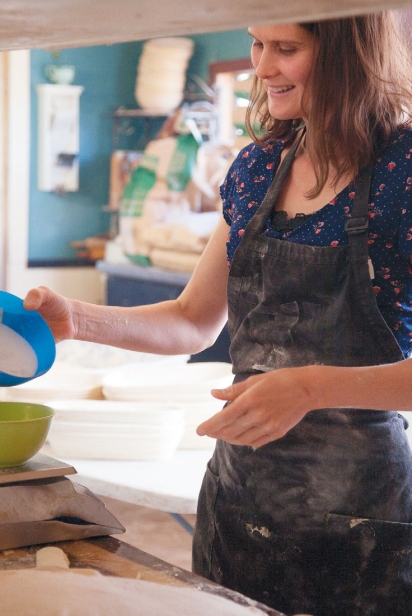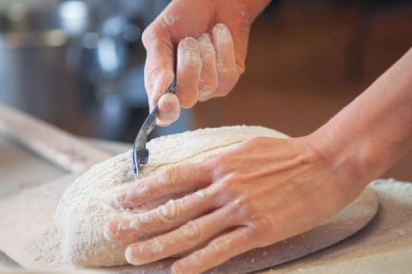Wingfield Bread Company: Camp Verde Rising
Rachelle Pozza’s Wingfield Bread Company stand at the Sedona Farmers’ Market is a cornucopia of luscious, fragrant, homemade breads and baked goods. Her mother’s chocolate chip cookies, great-grandmother’s ginger cookies, tender Danish and melt-in-your-mouth, yeast-raised whole-wheat donuts are staples. Depending on her inspiration, there may be buns, focaccia, pan-loaf stone-ground corn bread (either plain or with home-roasted chilies) or some other special that week.
To help you decide, one of her kids offers samples.
But for me, a former baker, her signature creations are the delicious sourdough breads. A triumph of whole-grain fresh-milled flours, natural fermentation and the work of her own hands, they have big airy holes and tender but chewy crusts. There is a whole-wheat sourdough, a mostly rye “Ranch Hand Sourdough,” a country-style white wheat sourdough called “The Artisan,” made with a starter named after her uncle Ricky Jay. “Providence” is infused with herbs. Other loaves have olives, garlic and rosemary, pecans and cranberries, or chocolate and dried cherries, as her whim dictates.
Rachelle’s breads are truly “artisanal”: handcrafted from fresh, minimally processed ingredients that depend upon time, nature and skilled craftsmanship. Like other traditional fermented foods such as wine, beer, cheese or barrel-aged vinegars, old-fashioned bread making is a delicate craft, a collaboration between the artisan and the unseen wild yeasts that yields a natural product with complex, rich flavors.
Rachelle is self-taught, led by inspiration and entrepreneurial spirit. For most of her life commercial bread was not a big part of her family’s diet; she says “it was tasteless, unsatisfying and did not agree with our health.”
That changed after she moved to Camp Verde, Arizona, the place where her pioneer ancestors had settled in the 19th century. (Her Wingfield ancestors’ home there is listed on the Register of Historic Buildings.) Relocating from Phoenix, where she grew up, was an act of faith, inspired by Rachelle’s vibrant, recurring dreams of women in long skirts and bonnets, horses and covered wagons—dreams that reflected her family history. Even though she had no contemporary connection to Camp Verde, and no particular plan in sight, she felt somehow compelled to relocate with her husband, Julian, and seven children to the town of her forebears.
After the move, friends gave her some bread made with flour they had milled themselves. Rachel and her family were so delighted with the flavor, the hearty quality, and the fact that they felt good after eating it, that she borrowed the mill and bought a 50-pound sack of wheat berries from Walmart.
She started to bake, and took her creations to the Camp Verde farmers’ market: The Wingfield Bread Company was born.
“It took a lot of creative adaptation to get it going, using a home oven and whatever tools we had at hand. In the beginning we just used coffee cups to measure out ingredients,” says Rachelle.
As the business grew, she bought three grain mills and found a small producer in Utah who sells whole-grain wheat and rye, a white winter wheat, as well as milled unbleached white flour.
She needed another oven to handle the additional volume, but how to afford a commercial bread oven? This was urgent! She gathered her family to pray for one. Then, a few days later while driving around with her husband they discovered a convection oven abandoned behind a restaurant. It was a mess, and it took them three months to refurbish it but they got it for free. Their prayer had been answered.
Her first breads were made with commercial yeast, but she preferred sourdough, and so after a couple of years she began to experiment with natural leavening.
Rachelle says, “Baking bread at home was a giant science experiment, and a steep learning curve; there are so many variables involved in understanding the process. There are many factors that lead to a flat loaf, for instance.
“Baking, for me is spiritually symbolic in that it requires faith in these unseen microorganisms that have a life of their own. It requires patience, because the yeasts need time to grow and develop, to bring out the taste and texture of the loaf. The flavor is there because of the whole-grain, fresh-milled flour, but the fermentation is key to the texture of the bread. Controlling the fermentation is crucial.”
Asked to describe the bread making process, she says: “I create a sourdough ‘mother.’ I start with freshly milled rye flour and make a slurry with the flour and water. The rye flour seems to create the best starters because it has yeasts on the grain—it attracts lots of microorganisms. I keep it in the fridge, and feed it when it gets dull and flat.”
She mixes starter with flour and water and lets it sit overnight; this is the leaven builder. The next day she mixes that by hand into another batter to create a dough, and then lets it rest. All the while, the yeasts are working and developing flavor, structure and texture.
When she sees that the dough is ready, she kneads it on a counter briefly, shapes it into a round and—after a long rest— folds and tucks the 16-pound mass gently, “keeping the top on top, the bottom on the bottom to keep the gluten structure intact.” This looks simple but it is tricky, rather like tossing pizza dough. Rachelle hand kneads three to five batches of dough every day because the commercial Hobart mixer is too strong for the naturally fermented whole-grain dough.
“When it is stretchy and cohesive, with big bubbles forming, you can see that it is alive.” It is tricky to handle the floppy, sticky dough; “the tendency is to fight it.” She handles it deftly, pats the springy mound and smiles: “It has the feel of a baby’s bottom.” After another rest on the counter, she cuts, weighs and shapes the dough into loaves, which rise in baskets a couple of hours until ready to bake. Scoring the tops with a razor, she loads them into the 400° oven, spraying them with a giant mister. When they have baked, she takes them out, cools them and slices them on an electric slicing machine before bagging and labeling them for market. In all, it takes a 16-hour day to bake for the market.
“Figuring out how to work with live grain was a challenge. White flour is much easier to handle, and shape. The wholegrain dough is more alive and hard to control. There is a lot of chemistry going on in it.”
And that chemistry gives the bread great flavor, nutrition and texture.
Long fermentation is how bread was made for centuries. Then, around 1900 commercial fast-rising yeasts were developed and bleached, bromated flours were introduced to enable fast, large-scale factory bread production. The nutritious wheat germ was removed to promote long shelf life. To make up for all that has been removed, factory bread has added wheat gluten, refined sugars, dough conditioners, vitamins and more.
Nutritionally and gastronomically Rachelle’s bread compared to commercial bread is like fresh fruit compared to canned.
Today there is a list of health problems attributed to non-Celiac gluten sensitivity leading to the current trend of gluten-free diets, and a plethora of questionable gluten-free substitutes.
Rachel believes this demise of a healthy food that sustained people across the world for millennia is lamentable. An advocate for bread’s nutritional value, she seeks to share her creative experience and educate the wheat-wary, fast food plagued public so that they can enjoy all the deliciousness and nutrition that whole grains have to offer— in good health and guilt-free.
“Even people who have gluten sensitivity can eat these breads. I have pages of testimony from people to confirm this.”
In business for five years now, she has developed a loyal clientele. Some days they sell out of bread after only an hour. European customers who return each winter say they miss her bread when they are away.
Like other artisanal, passionate bread bakers, Rachelle is on a mission: She would like the world to rediscover the glory of real bread, the kind that can be called the staff of life.
And about those donuts? “We have a cult following for the donuts. People line up to get them before the market opens.” I can assure you—like the bread, they are worth a long wait in line!








